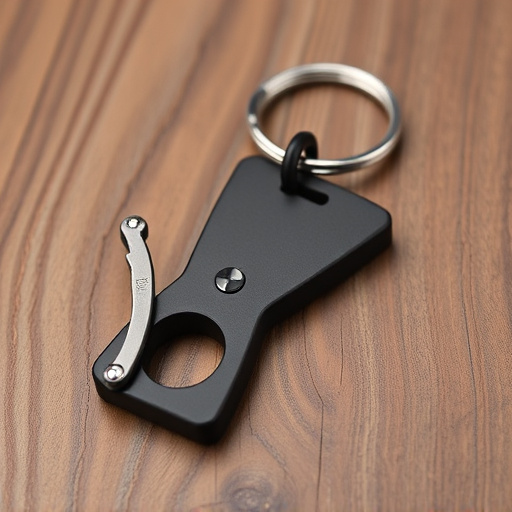Obtaining a keychain weapon permit is crucial for personal protection under strict legal frameworks. Designing such a device requires adhering to permit requirements, balancing compact size, easy deployment, and materials like stainless steel or titanium. Defense mechanisms can vary from pepper spray to stun guns, with key considerations including water resistance, slip-resistant grips, and advanced materials for durability and safety. The market is growing due to increased demand for subtle self-defense solutions, with relaxation of keychain weapon permit requirements driving innovation in compact, legal defense tools. Future developments may include smart sensors, customizable alerts, and AI-driven training apps.
In today’s diverse and often unpredictable world, personal safety is paramount. For those seeking discreet self-defense options, keychain weapons offer a unique blend of convenience and protection. This comprehensive guide explores the essential aspects of designing and utilizing keychain weapons, with a focus on meeting legal requirements for keychain weapon permits. From understanding key regulations to uncovering market trends, we delve into the future of discrete personal protection accessories.
- Understanding Legal Requirements for Keychain Weapon Permits
- Design Considerations for Discreet Personal Protection Keychains
- Essential Features and Materials for Effective Self-Defense Keychains
- Market Trends and Future Innovations in Discreet Self-Defense Accessories
Understanding Legal Requirements for Keychain Weapon Permits
In many jurisdictions, carrying a concealed weapon is regulated by strict legal frameworks, and obtaining a keychain weapon permit is a crucial step for those seeking personal protection. Understanding the specific keychain weapon permit requirements varies from region to region, but certain common factors are often considered. These include age restrictions, typically requiring individuals to be of a certain age to legally carry a weapon, and background checks to ensure the applicant has no disqualifying criminal history or mental health concerns.
The regulations also delineate the types of weapons permitted, with restrictions on blade lengths and overall weapon size, ensuring that keychain weapons remain discreet and suitable for their intended purpose. Additionally, training and safety courses might be mandated to educate permit holders on responsible weapon handling and storage, promoting both personal safety and public security.
Design Considerations for Discreet Personal Protection Keychains
When designing a discreet personal protection keychain, several factors come into play to ensure it meets the necessary keychain weapon permit requirements while maintaining a subtle aesthetic. The primary consideration is size and form factor; the device must be compact enough to fit comfortably on a keychain while still allowing for easy deployment when needed. This balance ensures that the keychain remains unnoticed in everyday carry situations.
Materials play a crucial role, too. Choosing durable yet lightweight options like high-quality stainless steel or titanium not only enhances longevity but also contributes to the overall discreetness. Finishes and coatings should be carefully selected to avoid reflecting light excessively, preserving the low-profile design intent. Additionally, incorporating features such as a secure lock mechanism and a swift-deploy trigger is essential, allowing for quick access in emergencies while maintaining discretion.
Essential Features and Materials for Effective Self-Defense Keychains
When designing a discreet personal protection keychain, several essential features and materials play a crucial role in its effectiveness as a self-defense tool. Firstly, consider the type of defense mechanism incorporated into the keychain. Options range from simple tools like pepper spray or a small stun gun to more innovative solutions such as folding knives or tactical flashlights with a strike function. The choice should align with your specific needs and local keychain weapon permit requirements.
Materials also significantly impact the performance and discretion of the keychain. High-quality, durable metals like stainless steel are ideal for structural support, ensuring longevity even with frequent use. For components that require flexibility or camouflage, materials like carbon fiber or textured rubber can be effective. Additionally, consider water resistance and a slip-resistant grip to enhance usability in various environments.
Market Trends and Future Innovations in Discreet Self-Defense Accessories
The market for discreet personal protection devices is evolving rapidly, driven by a growing demand for innovative and subtle self-defense solutions that seamlessly integrate into daily life. Keychain weapon permit requirements are becoming less stringent in some regions, fueling interest in compact, legal defense tools. Among these trends, advanced materials like titanium and ceramic offer enhanced durability and safety features while maintaining a discreet profile.
Future innovations in this space may include integrated smart sensors for early threat detection, customizable alerts, and even automated locking mechanisms. As technology advances, expect to see more sophisticated designs that blend functionality with aesthetic appeal. Additionally, the integration of AI-driven training apps could empower users to enhance their self-defense skills, making them better prepared in various scenarios.
In conclusion, the discreet personal protection keychain market is evolving to meet the growing demand for legal self-defense options. Understanding local laws regarding Keychain Weapon Permit Requirements is essential for consumers seeking such devices. As technology advances, we can expect innovative designs and materials that enhance effectiveness while maintaining discretion. By staying informed about these trends, individuals can make informed decisions to protect themselves in today’s diverse and dynamic world.
